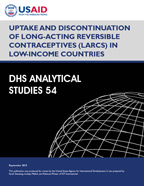- PUBLICATIONS
- JOURNAL ARTICLES
- ACCESS PUBLICATIONS
Publications Summary
- Document Type
- Analytical Studies
- Publication Topic(s)
- Family Planning, Fertility and Fertility Preferences
- Language
- English
- Recommended Citation
- Staveteig, Sarah, Lindsay Mallick, and Rebecca Winter. 2015. Uptake and Discontinuation of Long-Acting Reversible Contraceptives (LARCs) in Low-Income Countries. DHS Analytical Studies No. 54. Rockville, Maryland, USA: ICF International.
- Download Citation
- RIS format / Text format / Endnote format
- Publication Date
- September 2015
- Publication ID
- AS54
Download
 Uptake and Discontinuation of Long-Acting Reversible Contraceptives (LARCs) in Low-Income Countries (PDF, 1043K)
Uptake and Discontinuation of Long-Acting Reversible Contraceptives (LARCs) in Low-Income Countries (PDF, 1043K)
